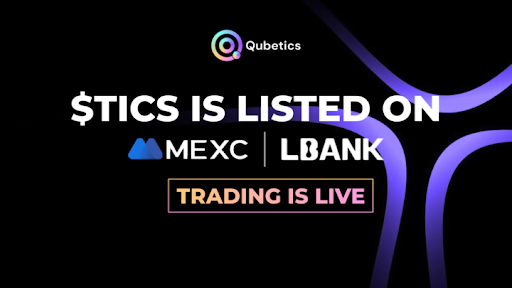Ethereum Price Prediction 2030: Will ETH Hit $20K as Qubetics Surges 950% Post Launch?
Ethereum eyes $20K by 2030 with Layer-2 scaling and institutional adoption, while Qubetics surges 950% post-launch, positioning itself as a rising DeFi and dev-tool powerhouse in 2025.

Ethereum remains the most influential smart contract platform in the crypto ecosystem. As of July 2025, the network supports thousands of decentralized applications and processes billions in daily value. With its Layer-2 integrations and deflationary model solidifying, long-term projections suggest ETH may reach $20,000 by 2030. Meanwhile, Qubetics ($TICS) has emerged as a breakout performer, soaring 950% within hours of its launch on MEXC and LBank.
Ethereum and Qubetics are both trending among the top cryptos on CoinMarketCap (CMC), making them central to the 2025–2030 market narrative. Ethereum’s utility continues to attract institutions, while Qubetics’ launch success and ecosystem tools hint at disruptive potential. This article dissects Ethereum’s long-term price prospects and unpacks Qubetics’ post-launch trajectory.
Ethereum’s Evolution: From Smart Contracts to Global Settlement Layer
Ethereum began as a decentralized platform to run applications without censorship or downtime. Since 2015, the protocol has transformed into a core financial infrastructure layer. The shift to proof-of-stake in 2022 (Ethereum 2.0) reduced energy usage and introduced staking, which now secures over 120 million ETH.
The London Hard Fork, particularly EIP-1559, introduced base fee burning. This shifted Ethereum’s issuance into deflationary territory. According to data from ultrasound.money, ETH’s supply has declined steadily in high-traffic periods, supporting price appreciation.

More importantly, Ethereum has become the backbone of decentralized finance (DeFi), stablecoins, and non-fungible tokens (NFTs). It supports the bulk of real-world asset tokenization and is increasingly used in AI-integrated protocols, such as autonomous agents and machine learning-based smart contracts.
These expanding applications point to growing demand for ETH as gas. By 2030, if ETH maintains network dominance and Layer-2 scaling continues, the asset could evolve into a global settlement layer for tokenized economies.
Ethereum Price Prediction 2030: Economic Models, Analyst Forecasts, and Risk Factors
Multiple forecasting models place Ethereum between $15,000 and $25,000 by 2030. A base case scenario assumes continued DeFi expansion, L2 rollup adoption, and a steady burn rate. Models from VanEck and CoinPriceForecast predict ETH reaching $20,000 to $22,000 based on these fundamentals.
A more bullish outlook sees Ethereum benefiting from the tokenization of traditional finance. The introduction of CBDCs, tokenized bonds, and securities would raise transaction volume, increasing ETH demand. Analysts from ARK Invest model a $25,000+ valuation assuming widespread usage across global banks and AI systems.
However, risk factors persist. Regulatory pressure from U.S. and European agencies could limit DeFi participation. Ethereum also faces stiff competition from Solana, Avalanche, and modular chains like Celestia. Technical risks such as smart contract exploits or failed upgrades could delay growth.
Despite these concerns, Ethereum’s growing validator network and composable applications continue to position ETH as a long-term asset. By 2030, price milestones depend heavily on whether Ethereum can retain its developer lead and institutional relevance.
Ethereum Layer-2 Integration: Catalyst for Scalable Growth
Ethereum’s scalability solution rests on Layer-2s such as Arbitrum, Optimism, and Base. These rollups offload computation and settle back to Ethereum, preserving security while increasing throughput. By 2030, most dApp activity may reside on these rollups.
This shift benefits ETH holders, as gas fees and validator rewards still route through the base layer. As more users and developers migrate to L2s, Ethereum remains the settlement finality layer. This foundational role drives long-term value accrual.
Emerging rollups adopting ZK technology offer near-instant confirmations and cheaper transactions. ZKSync and Scroll are examples gaining traction. Ethereum’s role as the trust anchor in this ecosystem ensures demand for ETH persists.
Institutional Demand: Ethereum as a Portfolio Anchor
Institutional involvement is another driver. ETH is now included in several spot ETFs and ETPs across Canada and Europe. The U.S. is likely to follow, with pending regulatory approvals under SEC and CFTC review.
Ethereum’s staking feature also attracts institutions seeking yield-generating assets. Staking yields vary between 4% and 7%, depending on network activity. With ETH acting as both a yield asset and a deflationary store of value, it increasingly resembles a digital bond.
Adoption by tech firms and banking consortia further cements Ethereum’s credibility. Protocol integrations, such as tokenized invoice systems and AI prediction markets, suggest an expanding use case pipeline.
Qubetics Launches Strong: A New Challenger Emerges
Qubetics ($TICS) exploded onto the market with a 950% surge after launching on MEXC and LBank on June 30, 2025. The coin also went live on SWFT Bridge, expanding cross-chain accessibility. Within 24 hours, MEXC trade volume surpassed $700,000, and Qubetics hit an all-time high of $4.20.
Currently, the token is witnessing strong buy pressure around the $2 support level. Analysts suggest that this demand zone reflects market confidence and institutional entry points. Qubetics is trending in the top 10 cryptos on CoinMarketCap, signaling heightened interest from both community members and algorithmic traders.
Qubetics Ecosystem: QubeQode and Qubetics IDE
Qubetics offers real-world value beyond price action. QubeQode is its no-code and low-code environment designed for deploying smart contracts, decentralized applications, and Web3 integrations. It allows users to build token economies and deploy dApps on multiple blockchains with minimal coding knowledge.
The Qubetics IDE (Integrated Development Environment) supports developers in testing, debugging, and deploying complex smart contract structures. The IDE also integrates with IPFS, enabling decentralized file storage for application frontends and metadata.
These tools appeal to developers, enterprise clients, and automation firms seeking to streamline blockchain adoption. Qubetics’ platform-centric model gives it a competitive edge in the smart contract infrastructure race.
Presale Performance and ROI Metrics
Qubetics concluded its presale with exceptional returns. The first stage of the presale launched at $0.01. By the 37th stage, the price reached $0.3370, representing over 3,270% growth before its exchange debut. Post-launch, the token listed at $0.40 and reached $4.20 within the first hour, a 950% spike from listing price.
From a strategic standpoint, the MEXC and LBank listings go beyond liquidity access. They enable mainstream retail onboarding, attract institutional market makers, and encourage developer exploration. The simultaneous listing on SWFT Bridge promotes interoperability and token velocity.
Projections suggest Qubetics could trade between $5 and $10 in the upcoming bull cycle. Support around $2 remains firm, bolstered by community engagement and rising trading volume. This is why Qubetics emerges as the best crypto ico to invest in 2025.
Closing Thoughts: Will Ethereum Reach $20K as Qubetics Rises?
Ethereum’s price trajectory toward $20,000 by 2030 rests on structural adoption, Layer-2 scalability, and institutional demand. The asset is evolving into a global trust layer for AI, tokenized assets, and programmable finance. Market momentum, validator growth, and developer retention remain core indicators.
Meanwhile, Qubetics has delivered a rare combination of post-launch price action and real-world application. Its development tools, strong presale performance, and ecosystem traction position it as a potential mid-cap disruptor. The success of QubeQode and its IDE can drive deeper integration in enterprise and DeFi workflows.
Both Ethereum and Qubetics illustrate how different layers of the blockchain economy are maturing. Ethereum holds the foundation; Qubetics is building agile, purpose-driven infrastructure atop it. Community members, developers, and data-driven analysts should monitor both closely as the decade unfolds

For More Information:
Qubetics: https://qubetics.com
Telegram: https://t.me/qubetics
Twitter: https://x.com/qubetics
Summary:
his article explores the projected trajectory of Ethereum (ETH), with forecasts suggesting a potential rise to $20,000 by 2030, driven by Layer-2 scalability, institutional adoption, and ETH’s evolving role as a global settlement layer. It also highlights Qubetics ($TICS), which surged 950% post-launch on MEXC and LBank, fueled by its developer tools, QubeQode and the Qubetics IDE and a successful presale that climbed from $0.01 to $0.3370. With both tokens trending on CoinMarketCap, Ethereum anchors long-term infrastructure while Qubetics emerges as a high-growth ecosystem challenger.



